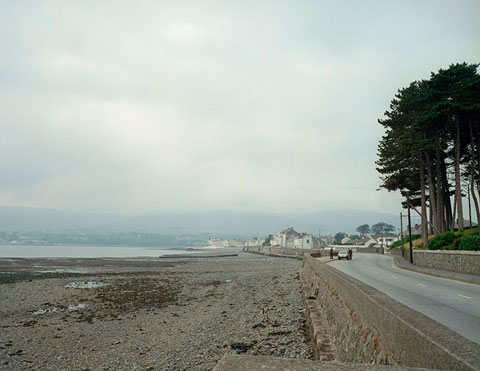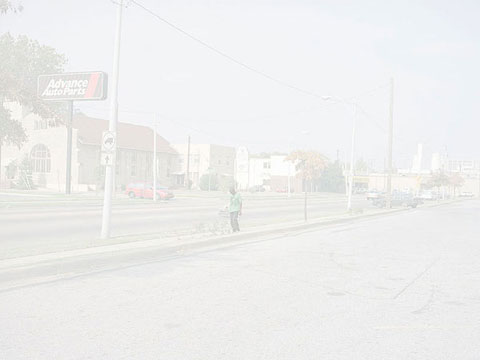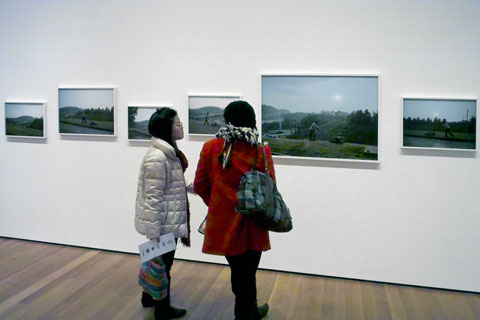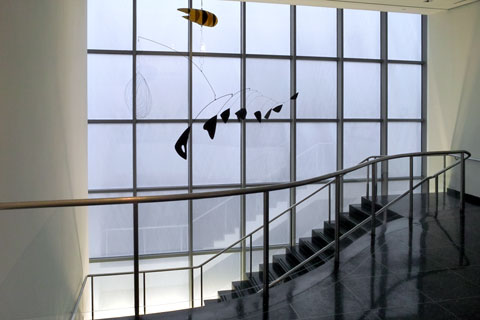
Photograph by Paul Graham from Troubled Land
Back when I was beginning to photograph the former Iron Curtain, I came across Paul Graham’s book Troubled Land, which dealt with the conflict in Northern Ireland. I was struck by the way he approached the issue as a landscape photographer, his pictures noting the small bits of evidence of the ongoing strife rather than confronting the action head on as so many photojournalists had. The picture above, for instance, shows a highway checkpoint from a distance. I felt a kinship there with the way I was looking at the landscape of the east/west border.

Photograph by Paul Graham from American Night
It’s been years since I’ve seen much of Graham’s work, although I knew that he had taken on other projects. I saw his American Night work, which I had mixed feelings about, the high key, blown out, images of figures walking or standing in neglected neighborhoods, juxtaposed with normally printed views of comfortable suburban homes. It seemed a little forced to me. But I’ve always appreciated Graham’s social engagement, even as his work clearly distances itself from the “concerned photographer” kind of documentary or journalistic photography. He is on the same turf as Walker Evans and Robert Adams on the big camera side of the equation, and Robert Frank and Michael Schmidt on the small camera side. Graham, of course, works in color, starting in the early 80s, and would have to be considered an early practitioner of that medium.
In recent years he has been working in image multiples or series. Not in the conceptual sense of serial photography, although it is obvious that he has thought a lot about contemporary photography and current trends. So, with his newest work now showing at the Modern–A Shimmer of Possibility–Graham has moved beyond the traditional “one off” approach of most street photography, that moments are defined strictly in terms of 1/125 second slivers of time. Graham is looking at situations, or short passages of time. Not a lot of action happens in these bits of real life Graham is attentive to, but they are as much about lassitude as anything else.

Paul Graham at the Museum of Modern Art — © Brian Rose
A man mows a lawn moving left and then right in the fading daylight. His van stands alone in the nearby parking lot–waiting. A man stands in a back alley smoking a cigarette. A woman eats a meal while seated at a bus stop. Graham records the woman and then looks down at debris on the sidewalk. These cinematic moments are like loops, a series of jump cuts, but something that would be hard to make arresting in film or video. It would all happen too fast without the considered apprehension that is the domain of still photography.

Paul Graham at the Museum of Modern Art — © Brian Rose
Most of the people in these photo suites are working class or underclass, often African-American. Many are seen in marginalized areas of the cityscape–alleys, parking lots, narrow sidewalks around strip malls, etc. Many are seen walking in places where more prosperous people would be driving. Many seem lost to their own thoughts as they attend to one chore or another–or are just waiting.
A few days after I visited Graham’s exhibit at the Modern I heard him speak at the SVA theater on 23rd Street. I was a little late getting there, and was surprised to be greeted by an overflowing hall of more than 200 people. I ended up on a metal folding chair parked off to the side of the stage. But he and moderator Philip Gefter just talked anyway–only a few photographs were shown. It was satisfying, if not inspiring, to hear him defend the continuing role of photography to observe the world around us–as opposed to the “synthetic” world that is particulary in vogue in the Chelsea galleries.

Museum of Modern Art stairs — © Brian Rose
I said hello at the end of the evening, and mentioned that I had a book out there called the Lost Border–a project spanning 19 years of history. He’d never heard of it, or me, which shows how far out of the mainstream I still am.
kind of surprised you expect people to somehow know of you or your work. I respect what you have done, but there’s also plenty of people out there who have a book out.
Graham himself has about 10 books, according to the resource website, and my teaching experience turns up plenty of photo grad’s who don’t know him (though hopefully this great moma show will change that) So – it’s a little much to expect people to automatically know you or your work through one book.
I dont know what your ‘mainstream’ comment is about either: all the best photography happens outside of the mainstream, including Graham’s, and always did! so do you really want to be accepted in the ‘mainstream’?!
Just do work that is unreservedly excellent. not ‘good’ not ‘as good as’ but: unquestionably amazing, groundbreaking, then people will get to hear of you and what you do. When something is that good nothing can stop word spreading.
I’m of the same generation as Paul Graham–I think I might be a couple years older. I know a number of the early practitioners of color photography. It’s a relatively small group. But our paths have never crossed–other than my brief hello last week.
The mainstream–I used the term too loosely–refers to the gallery world, the art marketplace, the media, publishing. It is, in my estimation, neither evil nor sainted, but it can make or break careers.
I don’t exactly buy “unreservedly excellent” or “unquestionably amazing.” I am more interested in work that aspires to something difficult to achieve. That something, I think, is often a moving target. And the ability to ascertain the target is subject to the vicissitudes of ones life. Relative success may or may not be immediately evident.
Regarding Paul Graham, I have always liked the restlessness of his work including his attempts to expand the notion of documentary photography while remaining rooted in the “real world.” Some attempts strike a chord more resonantly with me than others–which is normal–and can reflect my own shortcomings as much as his.
Whatever the case, I like what is going on in the “Shimmer of Possibility” series.